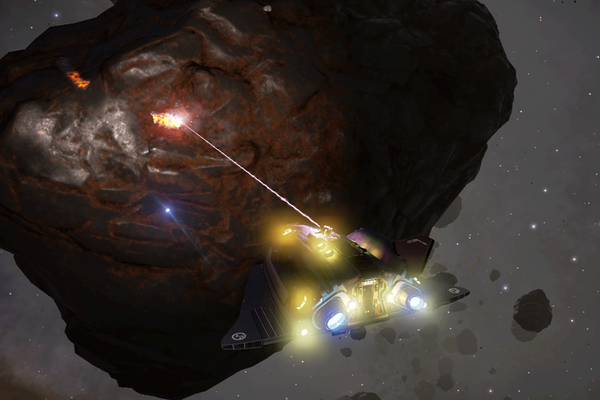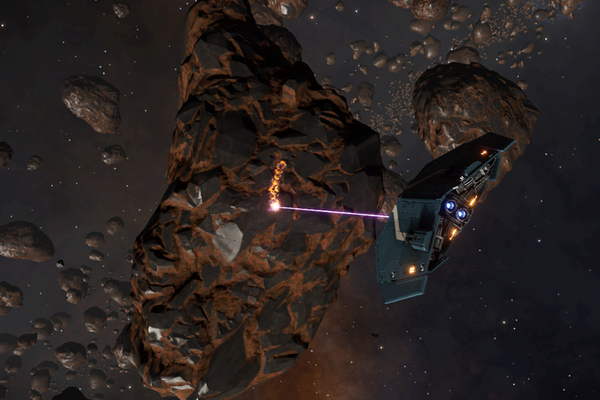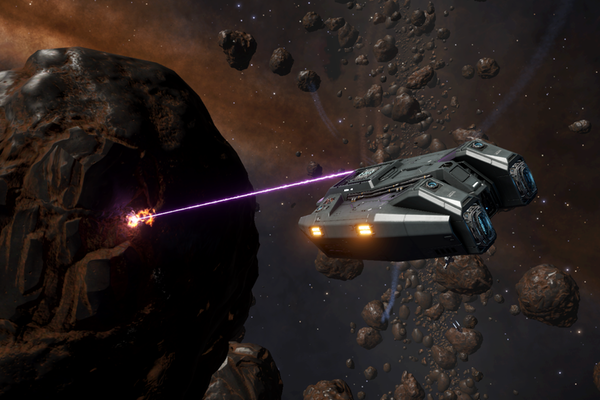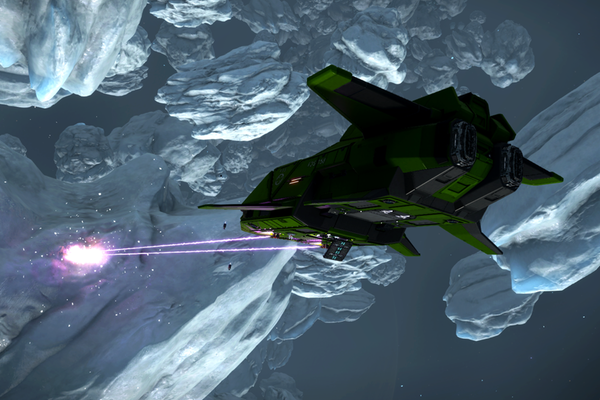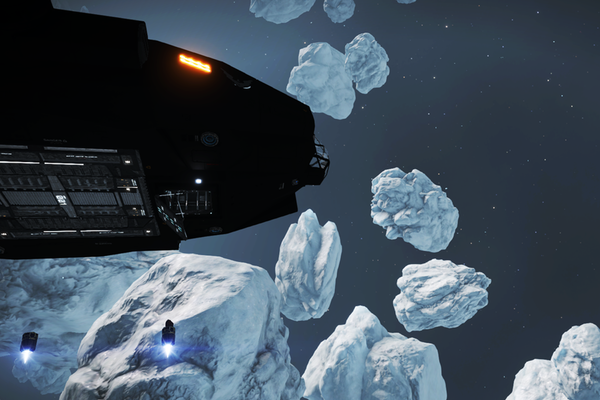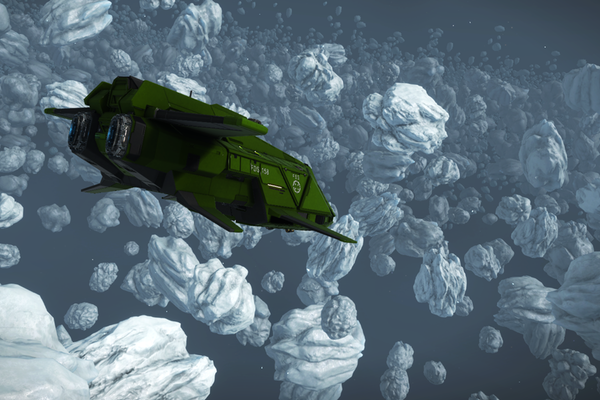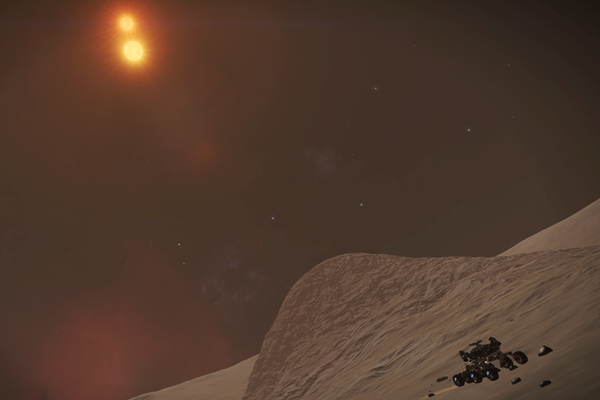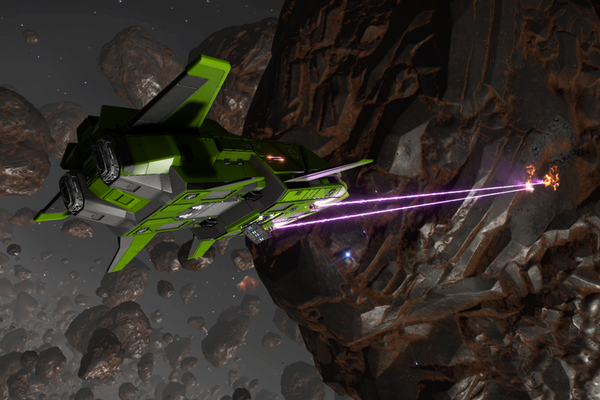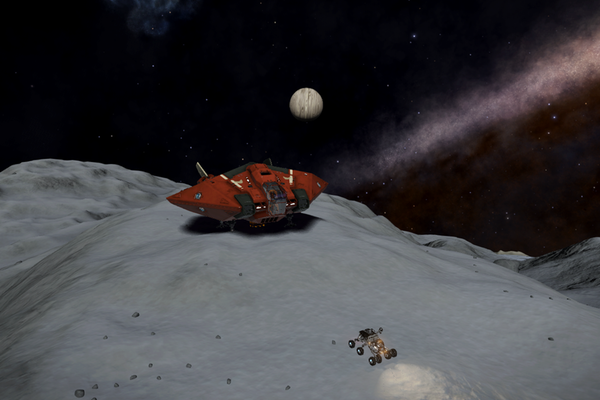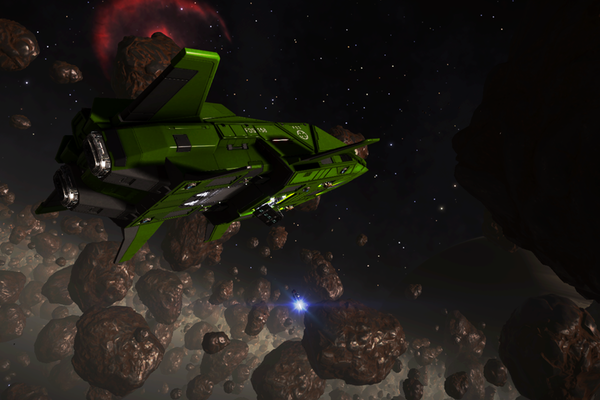Here, are the stiffening hills, here, the rich cargo
Congealed in the dark arteries,
Old veins
That hold Glamorgan’s blood.
The midnight miner in the secret seams,
Limb, life, and bread.
– Mervyn Peake
Fortunes, made and lost, hardship, betrayal, greed. Loneliness. If all of this sounds appealing, then the life of the Miner, in Elite: Dangerous, is for you. It’s not glamorous, and it’s not the most profitable profession in-game (though it’s not bad), but the opportunities for exploration and stunning vistas are endless, provided you can find rich reefs of ore, collect them efficiently, and avoid claim-jumping Pirates and ne’er-do-wells.
The Job
Mining in Elite: Dangerous is conducted in Asteroid Belts, Planetary Rings, and on Planetary Surfaces. The mechanics of mining in Asteroid Belts and Planetary Rings are exactly the same, but vary greatly from mining on Planetary Surfaces. For simplicity’s sake, going forward, I’ll refer to mining Asteroid Belts and Planetary Rings as Mining, and mining on Planetary Surfaces as Prospecting.
Mining, in-game, is conducted to gather metal ores, minerals, and chemicals for refinement and sale. At its most basic, the work requires the use of a ship equipped with, at bare minimum, a Mining Laser and a Refinery.
Prospecting is conducted to gather materials for Engineering and Synthesis. It requires only a Scarab SRV and a ship capable of landing that SRV on non-atmospheric, rocky Planetary Surfaces. With one very special exception, which I’ll discuss later, Prospecting is not conducted for profit. The materials gathered through Prospecting, at present, are only used for ship upgrades and modifications.
The Ship
Mining
Mining operations can be conducted in any ship that can outfit a Mining Laser and a Refinery, and still have enough room for at least one Cargo Rack. These minimum requirements are due to the fact that Mining is a process comprised of three distinct steps which result in salable metals, minerals, and chemicals: Fragmenting, Collecting, and Refining.
Fragmenting is achieved by striking the body to be mined, in this case asteroids chosen at random or scanned with a Prospector Limpet, with a Mining Laser. This causes fragments of ore to break off of the main body and drift into space. These fragments must then be collected through the use of the mining ship’s Cargo Scoop, either through the direct piloting of the ship by the Miner, or the use of Collector Limpets. Once collected, the ore is fed into the ship’s Refinery automatically, where it is processed into valuable commodities which are then stored in the ship’s available Cargo Racks.
The wise Miner also outfits their ship with some basic weaponry, shielding, and countermeasures. Asteroid Belts and Planetary Rings are havens for Pirates and other unsavory characters looking to make a quick buck by stealing someone else’s hard work. Few of them care if that someone is dead or alive at the end of the transaction.
Prospecting
Prospecting operations are carried out on the surfaces of non-atmospheric, rocky planetary bodies. All of the equipment necessary to conduct these operations is available in the Scarab SRV. In order to reach the surfaces of these planets, a ship with a minimum available size 2 compartment for outfitting a Planetary Vehicle Hangar is required. Thankfully, this is, at the time of this writing, every ship in the game including the starting Sidewinder. This is due to the fact that the prospecting and collection of materials for Engineering and Synthesis does not require Cargo Racks to store them. They are stored in separate bins, apart from Ship Cargo, that are built into every ship. Additionally, these earmarked bins travel with the pilot, from ship to ship, and survive ship destruction (presumably by being attached to the pilot’s escape pod).
Like Miners, the wise Prospector also outfits weapons, shielding, and countermeasures. While the chances of encountering highwaymen on planetary surfaces is very low, the chance exist and there’s nothing worse than showing up to a gun fight empty handed.
There is one specific instance where Prospecting does require Cargo Racks, and that is in the collection of Meta Alloys. Meta Alloys are a specific and rare commodity only found on Barnacles. Barnacles are only found on planets in nebulas and, because the closest nebulas to The Bubble are several hundred light years away (specifically in the Pleiades), this form of Prospecting is probably best left to Explorers with ships outfitted for long range travel.
Doing the Work …
Mining
The work of the Miner involves navigating asteroid fields and planetary rings, sampling asteroids, drilling them with Mining Lasers, and collecting and refining ore. Knowing where to find specific ores, minerals, and chemicals is also a large percentage of the Miner’s workload.
Mining locations are categorized into five types, based on their reserves of ores: Pristine, Major, Common, Low, and Depleted. These types range from nearly untouched reserves (Pristine), to not even worth it for sand (Depleted). The locations are further subdivided into categories based on the types of ores they have in them: Metallic, Metal Rich, Rocky, and Icy. The frugal Miner should, ideally, spend most of their time in Pristine Metallic rings and asteroid fields. This is because the most valuable ores and minerals (Platinum, Palladium, and Painite) are found there in large quantities. Thankfully, there is a web-based tool for locating systems with Pristine Metallic reserves, based on the miner’s current location.
The Pristine Metallics Distance Calculator allows you to input the system you are currently in and then provides you with a list of systems, ordered by distance, which contain asteroid fields and planetary rings with Pristine Metallic reserves. Even if you are looking for something other than the big three, the tool is useful because most systems have more than one type of ring, and the Pristine moniker applies to all rings in the system. A chart of ores, minerals, materials, and chemicals, and which types of rings they can be mined in, can be found here.
Once you arrive in a system with Pristine rings, you’ll need to determine which body and ring to head for. I’ve mentioned Asteroid Belts a lot so far, but really they aren’t that great for mining, even when Pristine. This is because they are generally composed of clusters of a few asteroids, scattered over very long distances. Ideally you want massive fields of asteroids to work with, and those are found in Planetary Rings. Using the System Map (left HUD panel), you’ll need to look at the details of the ringed gas giants in the system; you’ll be able to see what types of rings each planet has (Metallic, Metal Rich, Rocky, or Icy). Each ring is labeled, A, B, C, etc., with the A ring being the ring closest to the planet. Simply target the planet with the ring type you want, and supercruise to it.
As you approach the ring you’ve chosen, you may notice Resource Extraction Sites (RESs) of various threat levels (Low, High, and Hazardous) in the rings. Mining in these sites gives you a bonus to yields; the more dangerous the site, the higher the yield bonus. The trade-off is that these sites are thick with Pirates. In my estimation, the amount of time you’ll spend fighting and/or running from Pirates negates any yield bonus, unless you’re Mining in a Wing with a Bounty Hunter defending you. When you mine in a Wing, everyone in the Wing, when the Miner’s haul is sold, gets a cut. This fee doesn’t come out of the Miner’s profits, but is instead paid out by the Pilots Federation. This is a very cool thing and the Miner and Bounty Hunter sort of act symbiotically, with the Miner attracting Pirates and the Bounty Hunter taking them out. But, if you’re Mining solo, RESs are to be avoided.
The solo Miner should instead pick a spot, on the same ring, as far away from any RESs as possible (preferably in a spot lit by the nearby star), and make a controlled crash into the asteroids there. This is achieved by aiming at that spot then, as you approach, decelerating to one mega meter per second or less and simply allowing your Frame Shift Drive to drop you into the rings automatically when you get too close. Once in the ring, in normal space, point your bow toward the planet and boost until any ships, that popped up on radar, disappear. From this point on you’ll be able to mine without any interruptions. CMDR Raduk gives a great demonstration of this technique at the 12:40 mark of his mining tutorial.
Once you’re safe and alone in your little corner of the ring, it’s time to get to business. Choose any rock and launch a Prospector Limpet at it (you don’t need to target the rock, just get close, point your bow at it, and launch). As the Limpet leaves your ship, target it (using your Select Target Ahead button or key). Once the limpet attaches itself to the asteroid, it will scan its makeup and display the readings in the lower left of your HUD. If the rock doesn’t have good percentages (20-30%) of what you’re looking, try another rock and repeat the above process.
Once you find one that has what you want, launch your Collector Limpets, open your Cargo Scoop, and start drilling until the asteroid is depleted (if you keep the Prospector Limpet targeted, you’ll be able to see how much reserves the asteroid has left). Finally, let your Collector Limpets finish collecting all the bits, close your Cargo Scoop and move on to the next rock. Collector and Prospector Limpets do expire, so you’ll need to take a good amount with you. I usually fill my Cargo Racks about 40% full of limpets before leaving a station to go mining. The limpets can be found in the Restock menu of Starport Services.
You will occasionally need to manage the hoppers in your Refinery and your Materials inventory, jettisoning any common ores and materials. This can be accomplished through the Inventory screen in the right hand HUD. Again, CMDR Raduk gives a great demonstration of this whole process here. Now, in his case, CMDR Raduk is mining to fulfill missions he’s picked up, but the process is exactly the same as when you mine for your own needs.
Once your Cargo Racks are full of precious metals, minerals, and chemicals, and/or your limpets are spent, it’s time to sell your haul. The Pristine Metallics Distance Calculator does list the best place to sell, for each Pristine system, in the Hi Sell(dist)Pad column, which is a good place to start. You can also use EDDB‘s Commodities page to find up to date points of sale. Simply enter the commodity(s) to be sold in the Commodity text box, choose Sell from the Buy/Sell drop-down, and enter the system you’re currently in in the Current System text box. Then, click Find Stations in the lower left. It should provide you with a list, ordered by distance, of good places to sell. You can further filter this by choosing whether to include Planetary Stations in the list and/or only show stations with certain Landing Pad sizes, from their respective drop-downs. Whichever tool you use, though, simply fly to your point of sale and sell your goods on the Commodities Market. Of course if you were mining to fulfill missions, then you’ll need to deliver the goods to wherever the mission specifies.
Prospecting
As mentioned earlier, everything you need to complete planetary surface Prospecting operations is aboard the Scarab SRV. These include a Wave Scanner, Dual Repeaters, a Data Link Scanner, and a Cargo Hatch. With these four tools, the process is pretty straight forward. Locate a Point of Interest (POI), by flying over the surface of the planet; they appear as violet colored ovals (in the default UI color). Once you’ve found one, land in it and deploy your SRV. Now, drive around while watching your Wave Scanner; it’s the sweeping radar in the bottom middle of your HUD.
Because Elite: Dangerous is made by science nerds (which I love), the contacts on the Wave Scanner appear as wave patterns and sounds, specific to each type of contact. You can use WaveScanner.Net to aid you in identifying the different patterns and sounds. You’re looking for everything but Barnacles, Caches, Nav Beacons, and Your Ship. Once you locate an outcrop, you target it with your Dual Repeaters and blast it into chunks which you can scoop up with the SRV‘s Cargo Hatch. These items appear in your Materials Inventory and don’t take up cargo space. The Data Link Scanner is used for scanning any Data Points you come across. And that’s pretty much it. It’s a long tedious process, and there are many Materials you can get from asteroid Mining, so Prospecting is something I mostly recommend for Explorers looking to break up the monotony of deep space exploration.
… With the Right Tools
Mining
Outfitting a ship for Mining can be straight forward or complex depending on your goal. All you really need are Mining Lasers, a Refinery, and Cargo Racks. Collector and Prospector Limpets definitely make things much less tedious, so I’d highly recommend those as well. I personally mine in Elite: Dangerous while I’m doing something else outside of the game, so I’m not super interested in Credits per Hour like many of the folks over at the r/EliteMiners subreddit. There you will find all sorts of tips and tricks for Mining, and even charts and formulas for calculating the optimal Mining Laser to Power Distributor to Collector Limpet ratio. There is also an excellent post on Mining Ship outfitting and progression, by Neuromaster, there.
Neuromaster‘s ship builds rely heavily on the math done by Nazgutek, so they are optimized for Credits per Hour. A lot of them even run without Shields, which I don’t recommend anyone do, but there it is. Still, even if you’re not interested in min/max mining, they are good starting points. You can adjust them to your liking, and, if you need help, I have a post on ship outfitting that offers some general pointers.
My current Mining ship is a Federal Dropship. You can see how I’ve outfitted here. It has everything I need in the way of Refinery, Collector and Prospector Limpets, and Cargo Racks. The two medium Mining Lasers are more than enough to chew through rocks. In fact, the four Collector Limpets I have (two limpets per controller) usually can’t keep up, so I deplete asteroids long before they’re done collecting. This is intentional for me, as I like the downtime to do other things, outside of the game, when I’m Mining. It has no weapons, but I did outfit good Shields, Shield Boosters, Chaff Launchers, and Point Defense. These are mostly for when I get Interdicted on my way to sell my haul, so I also have good Thrusters and a top rated Power Distributor. The Power Plant is just enough to power all my goodies, including the top rated Frame Shift Drive, for getting to Pristine systems and points of sale. This ship suits my needs for how I like to mine, but your mileage may very. Check out Neuromaster‘s builds and play around. Figure out how you want to approach Mining, and tailor as needed.
Prospecting
Ship outfitting for planetary surface Prospecting is dead simple. Your ship only needs enough compartments to outfit a Planetary Vehicle Hangar, which holds the Scarab SRV. A ship dedicated to this sort of work would also be well served by a Detailed Surface Scanner. This scanner will allow you to target potential bodies to determine the mineral content of their crusts. In this way you can narrow down likely planets that might have the sorts of outcrops you’re looking for. It’s probably best to either outfit your usual mission running ship for this sort of work, or dedicate a small ship like a Hauler for it. Trying to outfit your mining ship with an SRV and Surface Scanner will just eat up compartments best used by Cargo Racks or Limpet Controllers. Smaller ships are best for Prospecting because they handle landing on high gravity planets better. Of course, that doesn’t mean you couldn’t outfit a Type-9, and Anaconda, or a Cutter to do both Mining and Prospecting. That’s entirely up to you. I’m just here to offer advice.
Wrapping it up
However you choose to approach Mining in Elite: Dangerous, I hope you’ve found some things in this post to get you started on your way to making credits and seeing the sights. The life of the Miner may not be the most exciting, but for me it’s a relaxing way to make some credits and see some gorgeous vistas, while I’m doing something else. If the idea of the beautiful sights Elite: Dangerous has to offer tickles a little corner of your heart, tune in next week for my post on Explorers.

